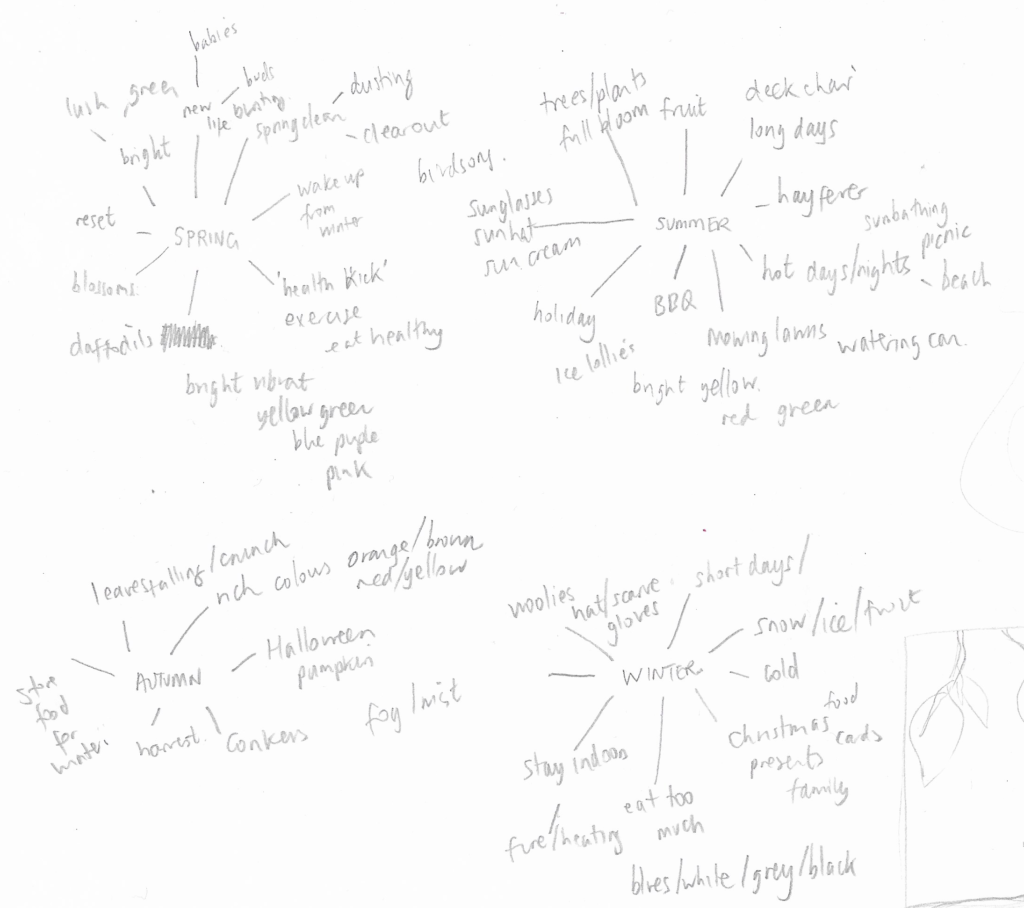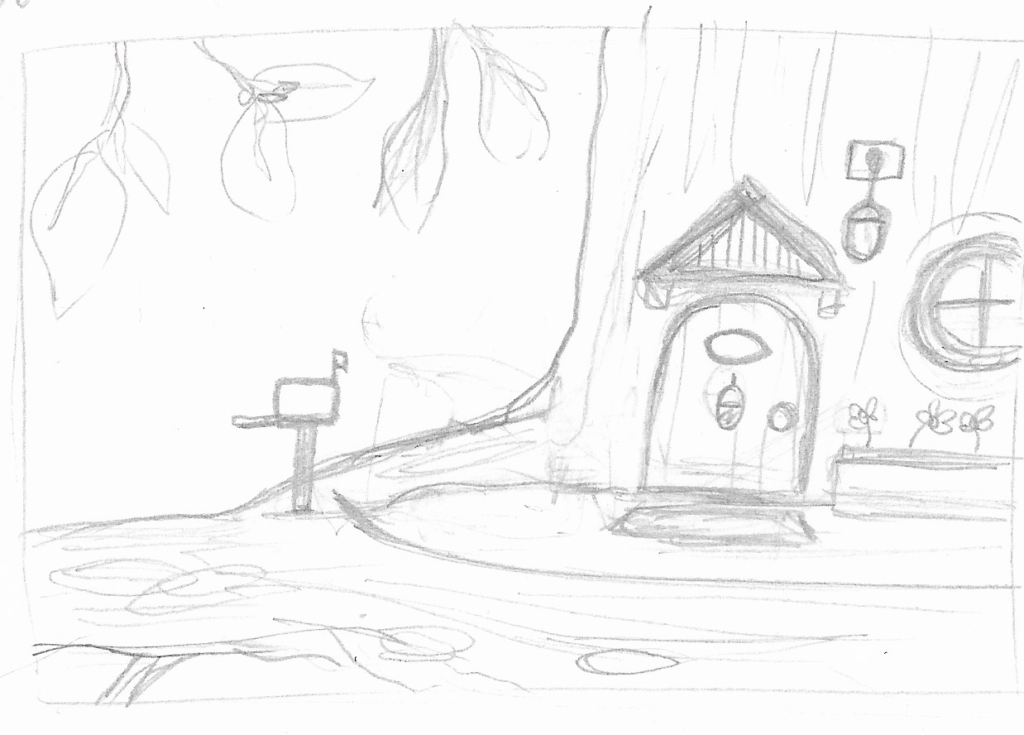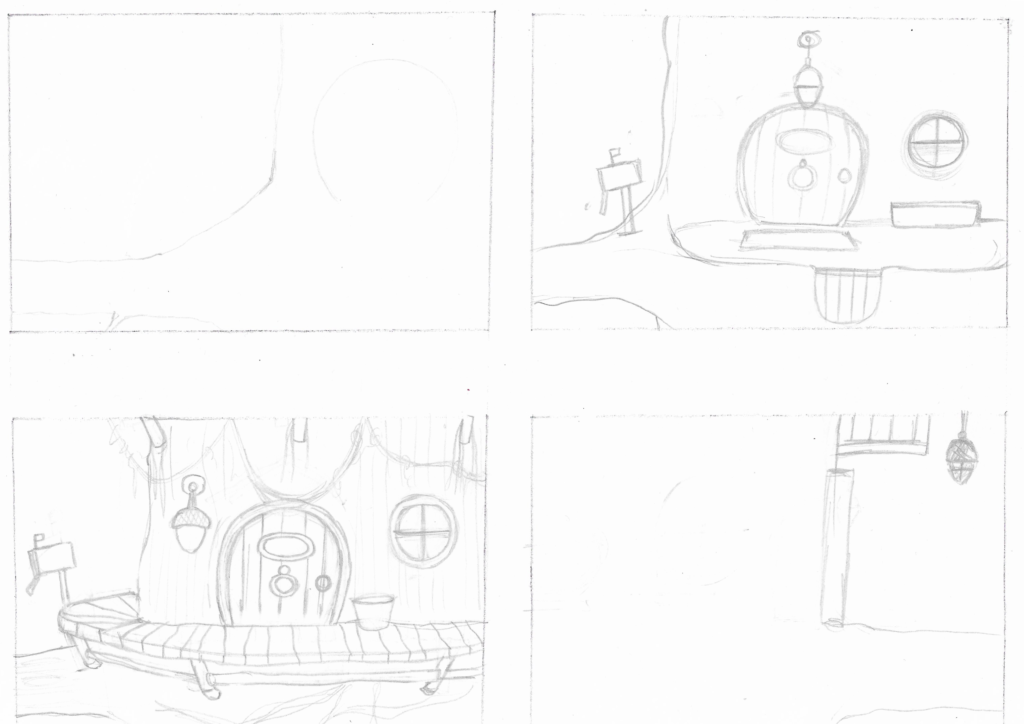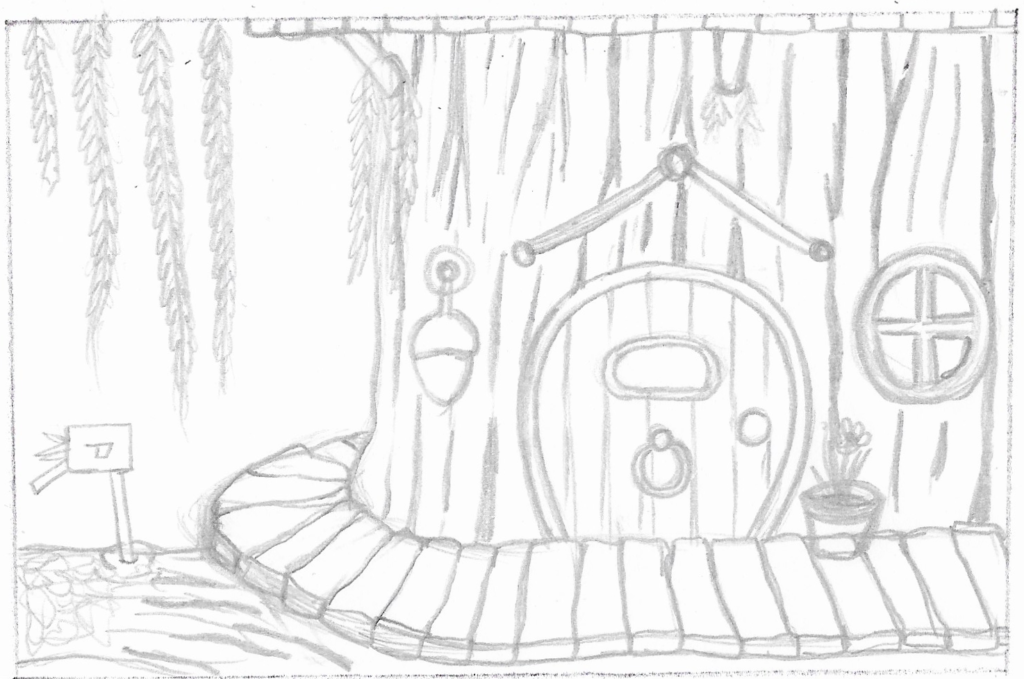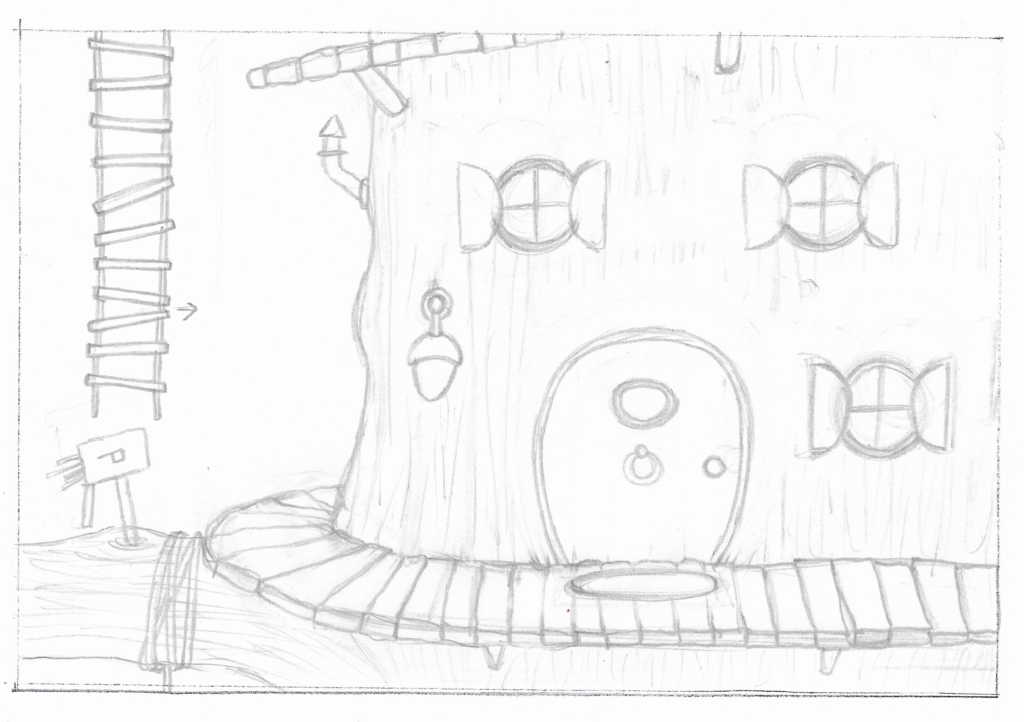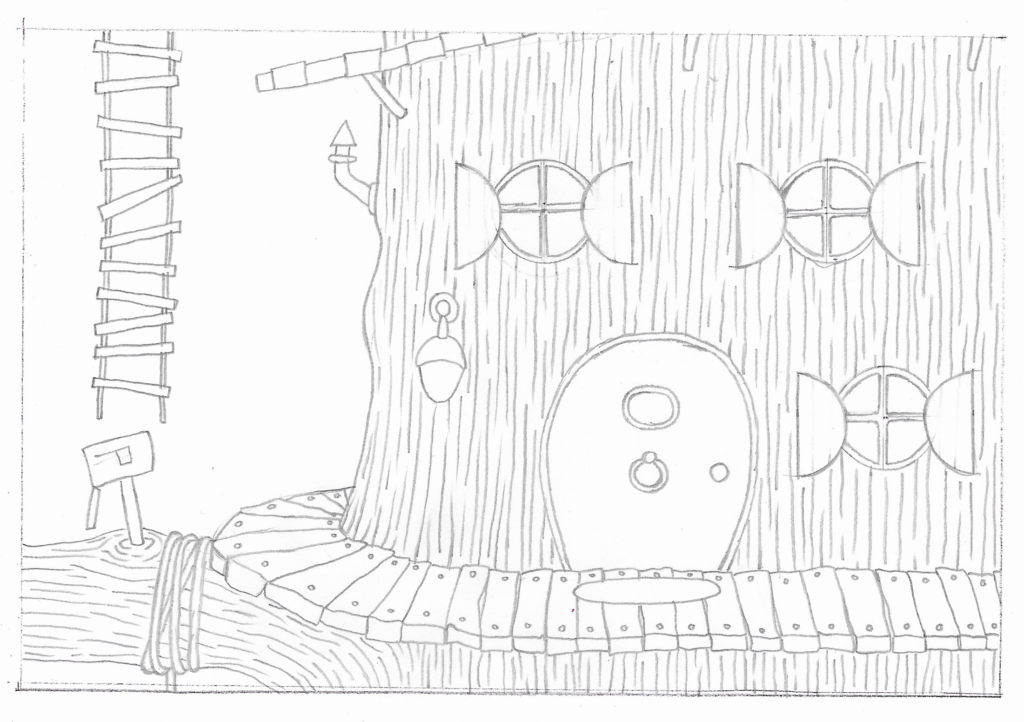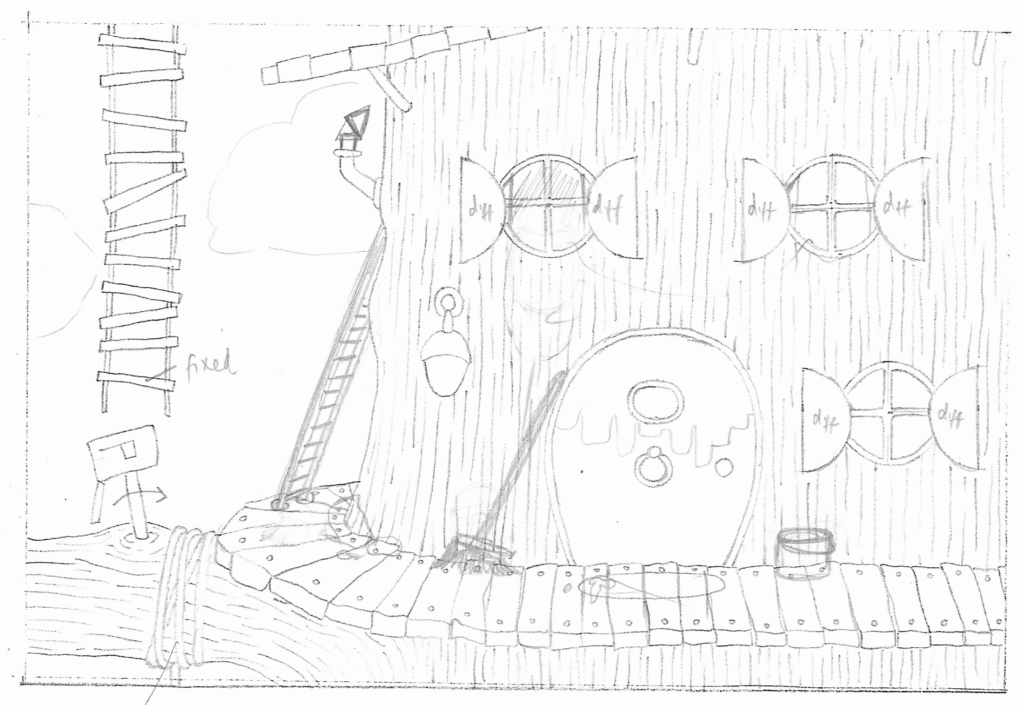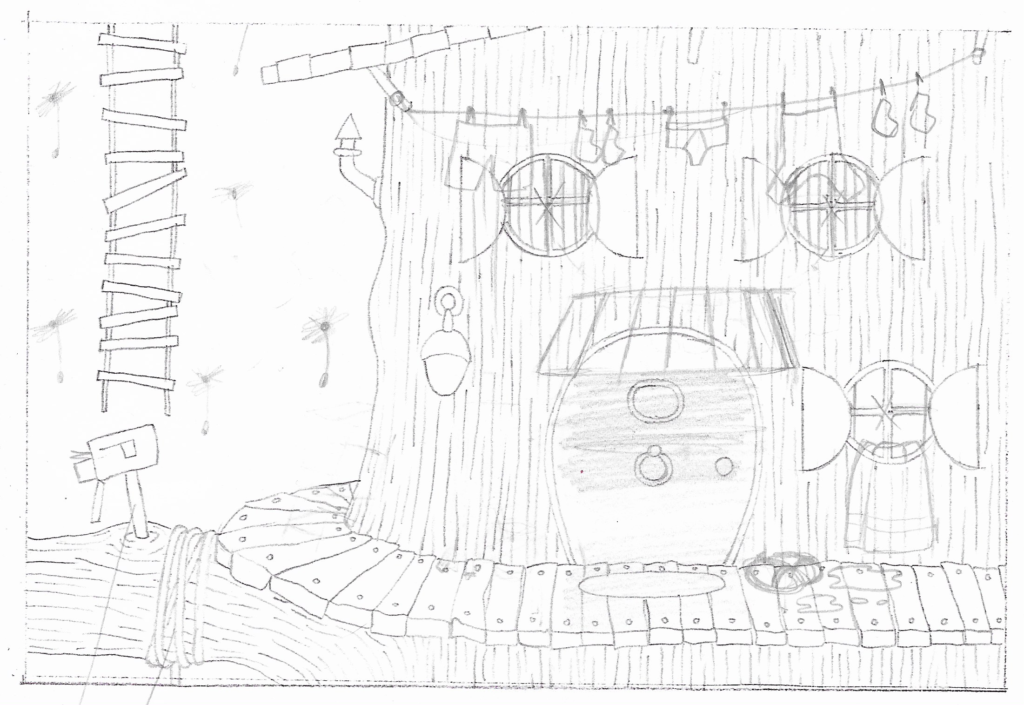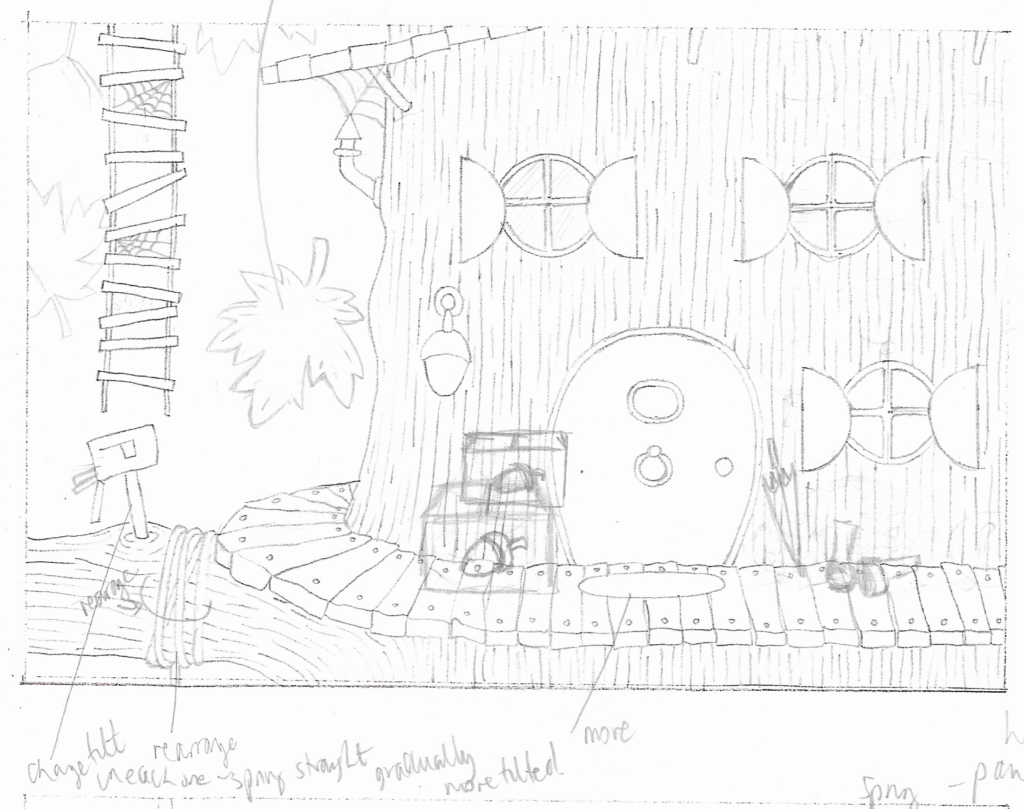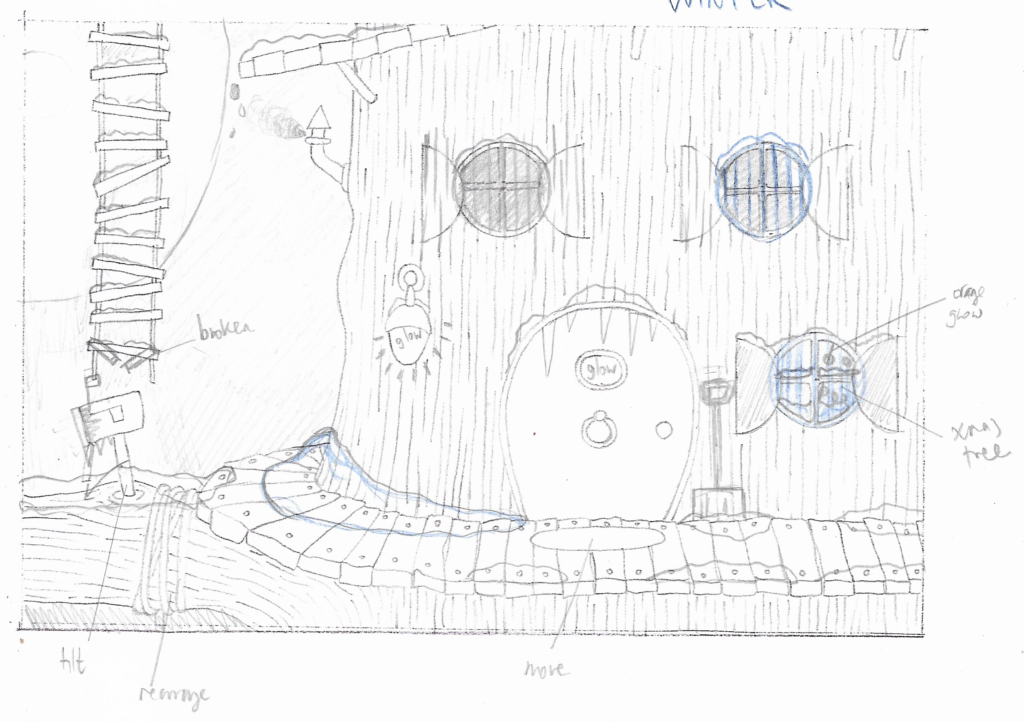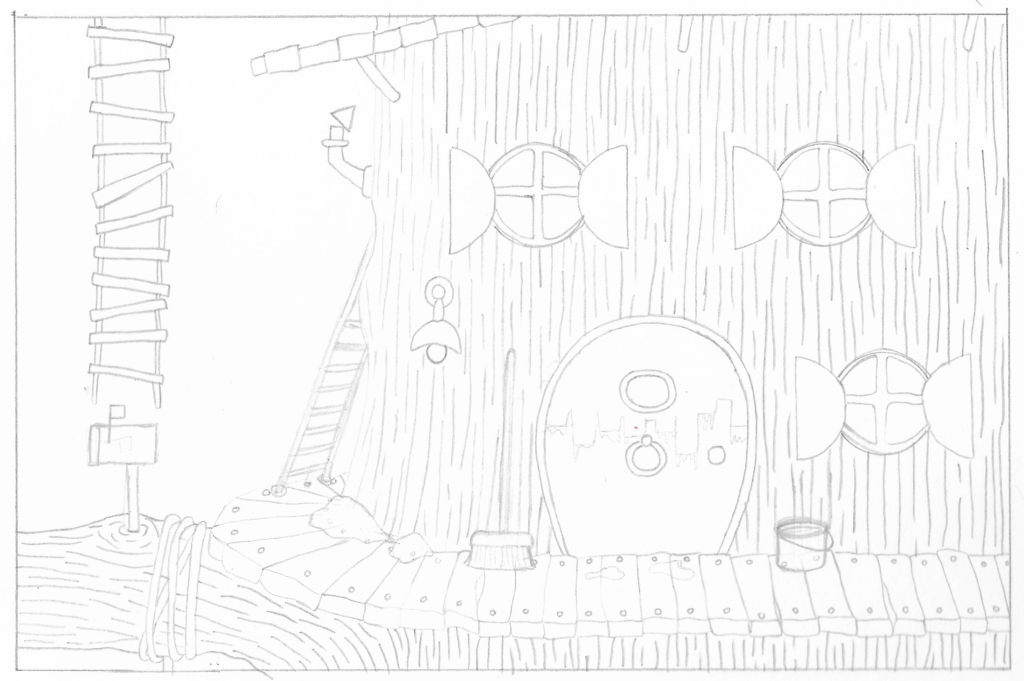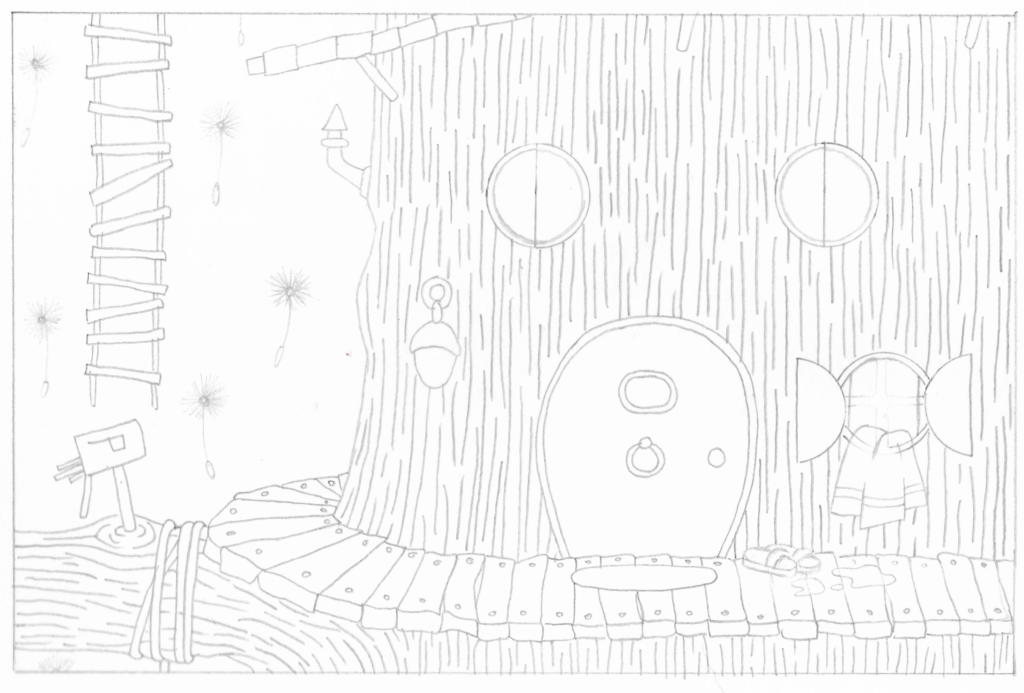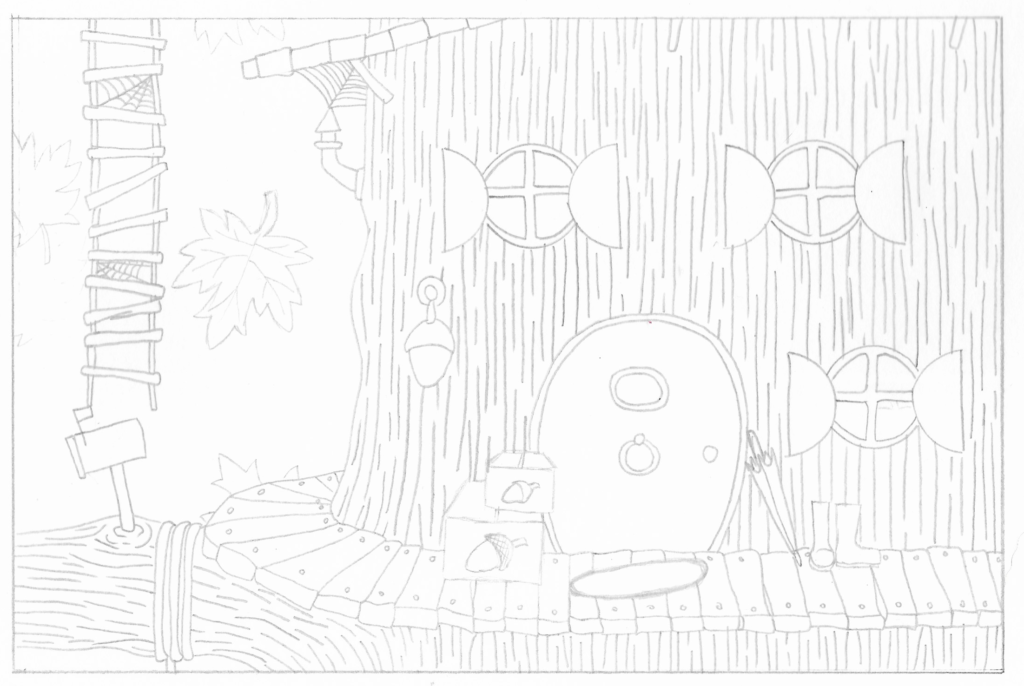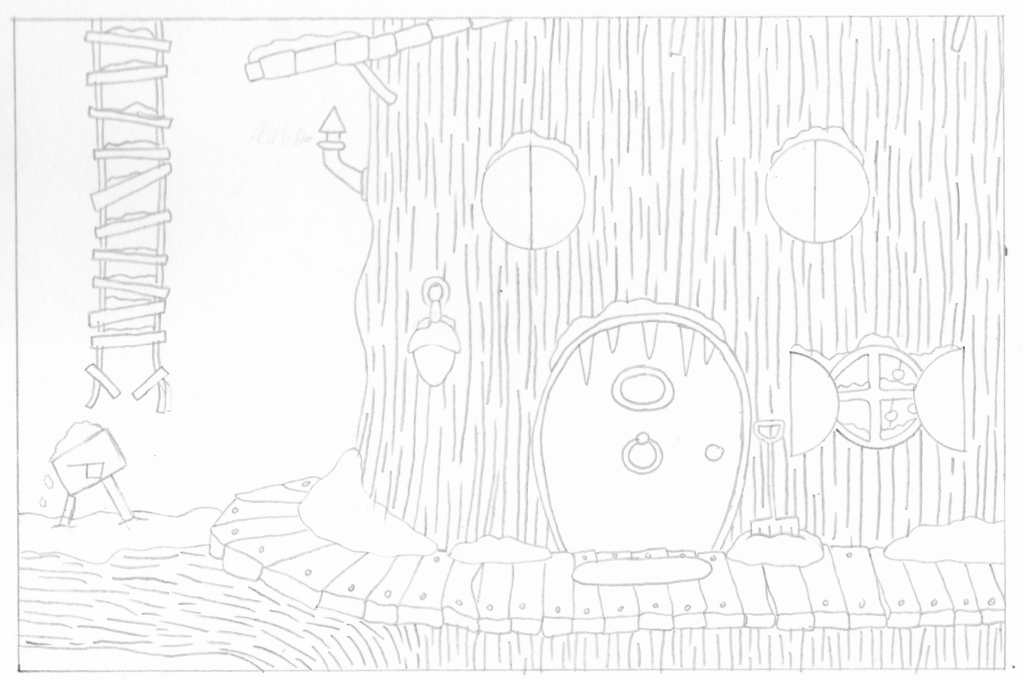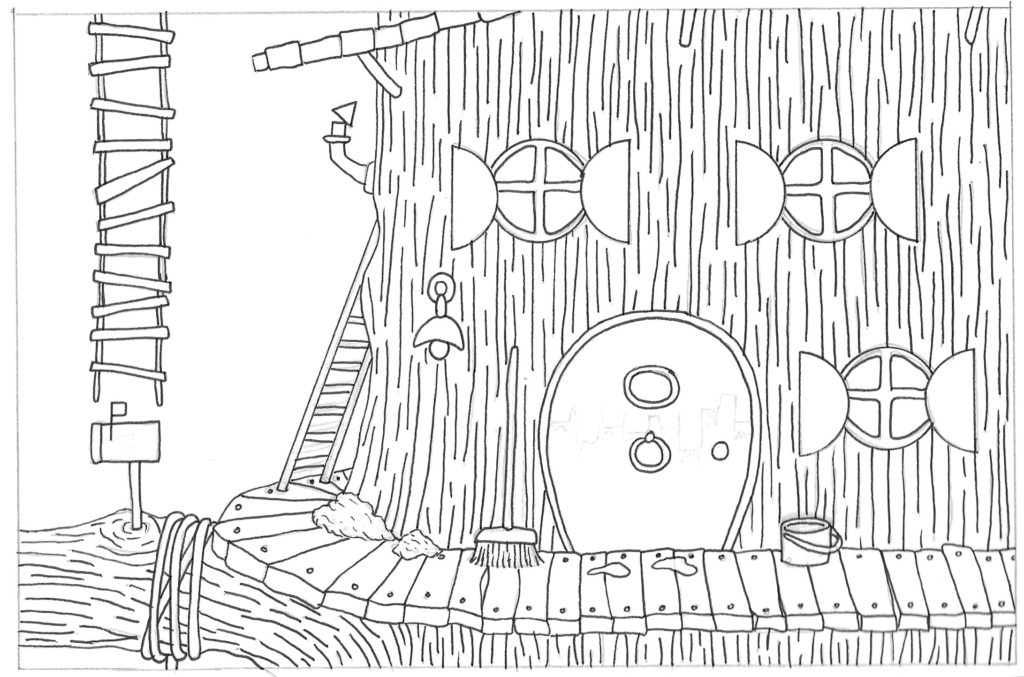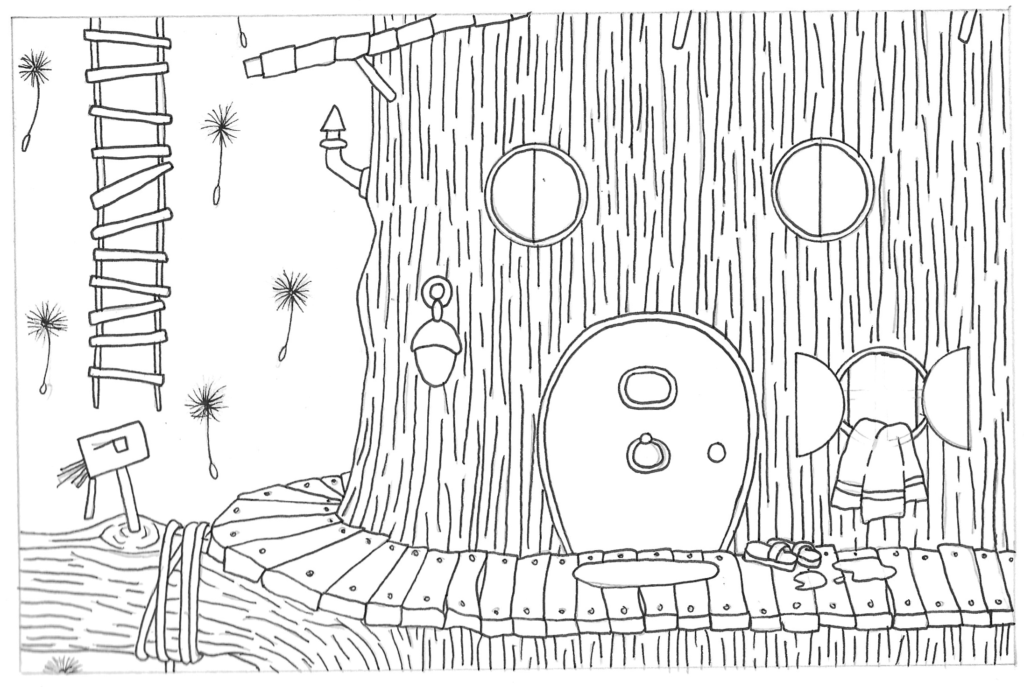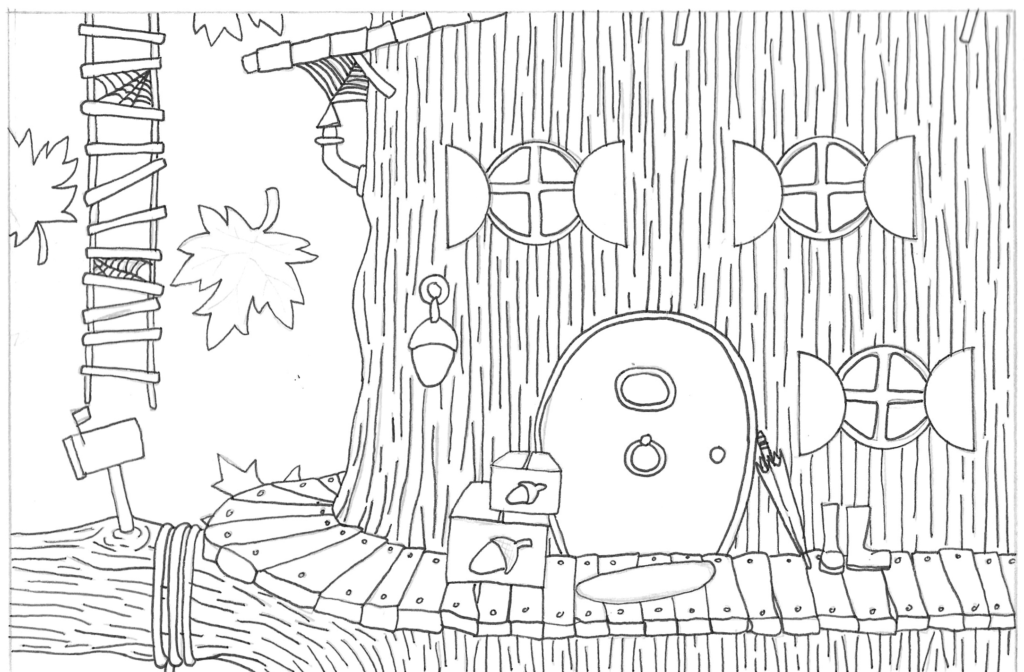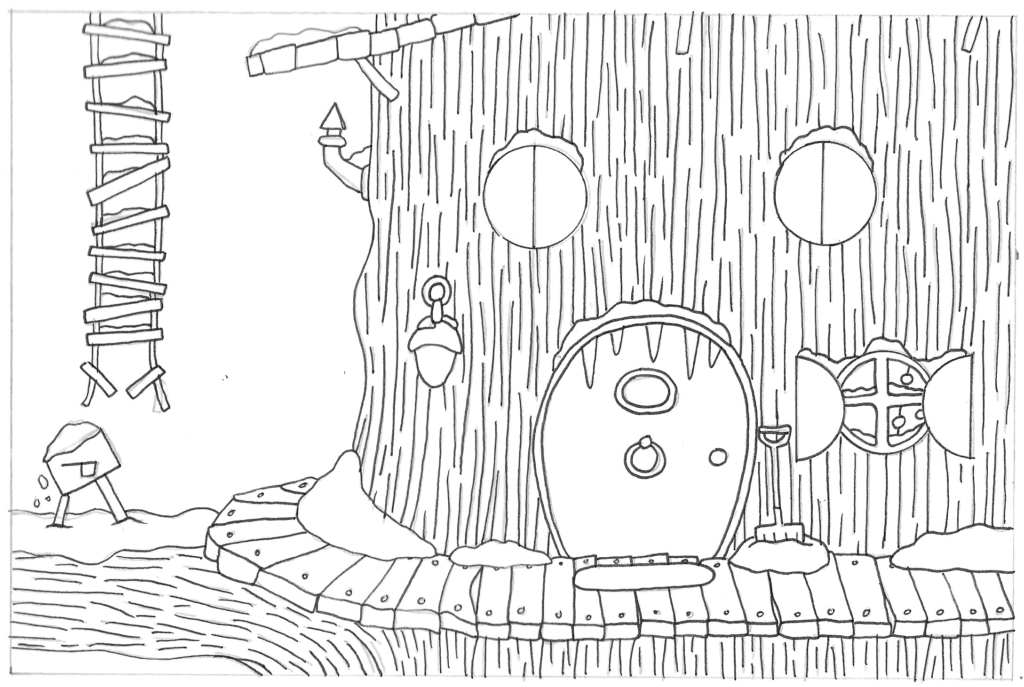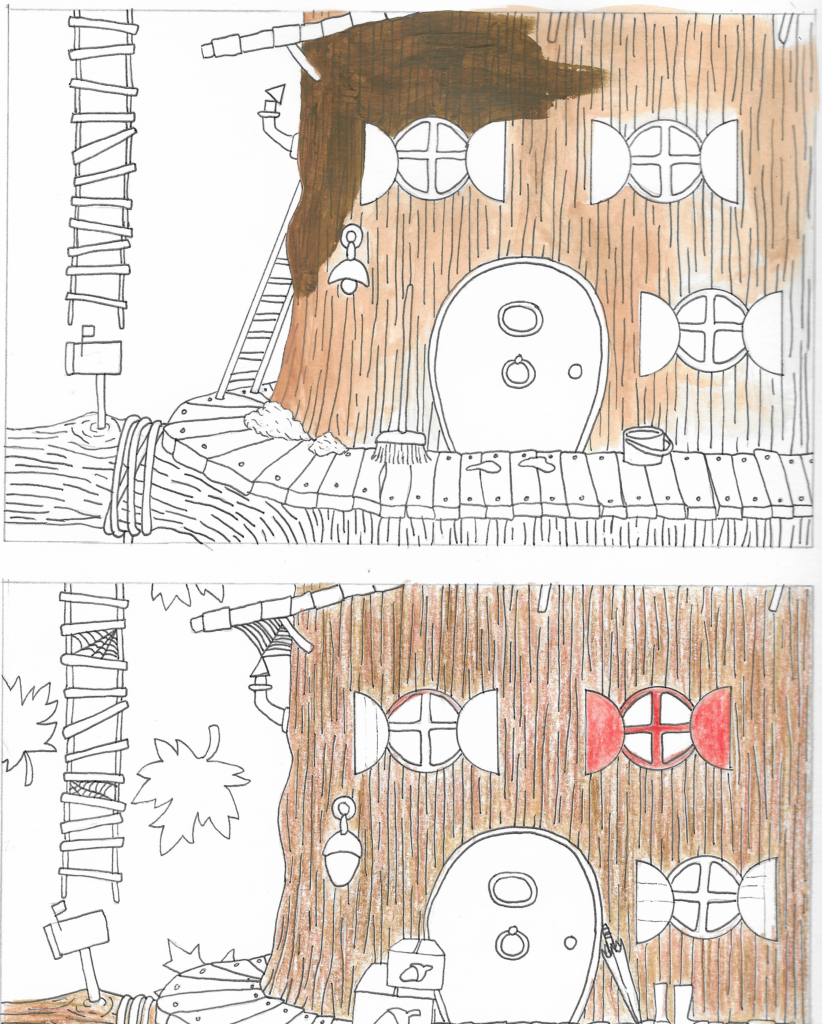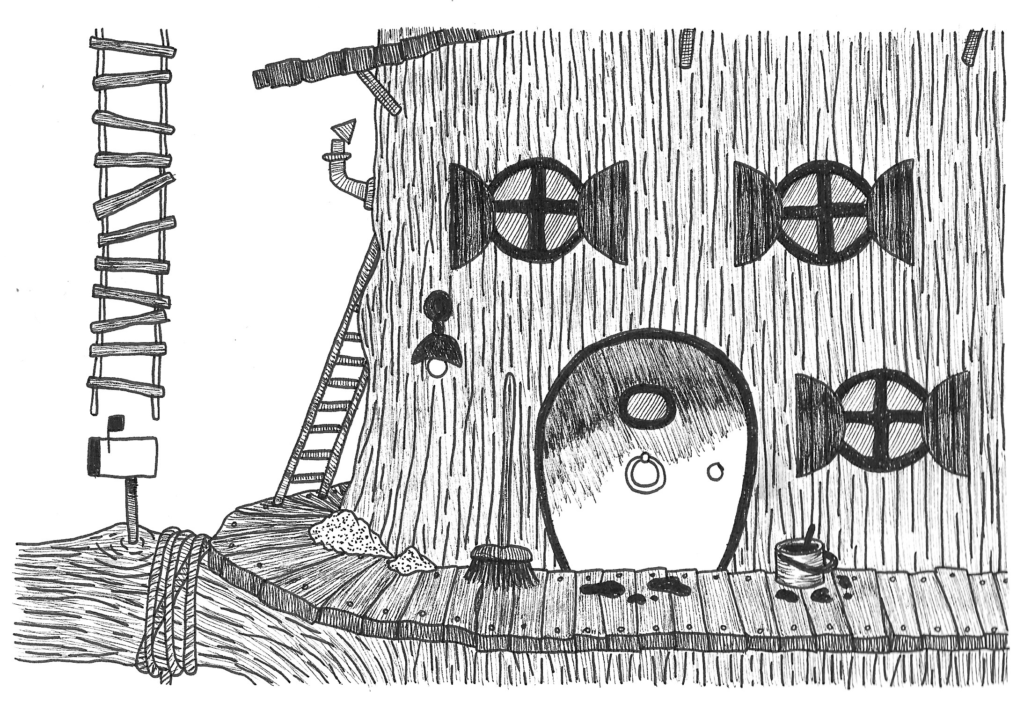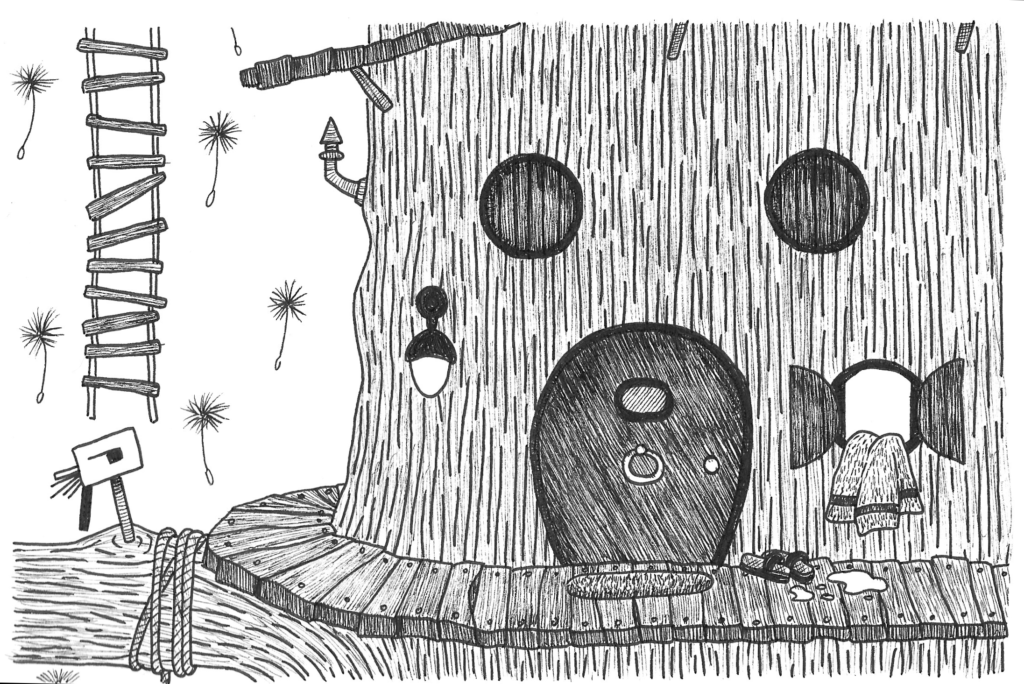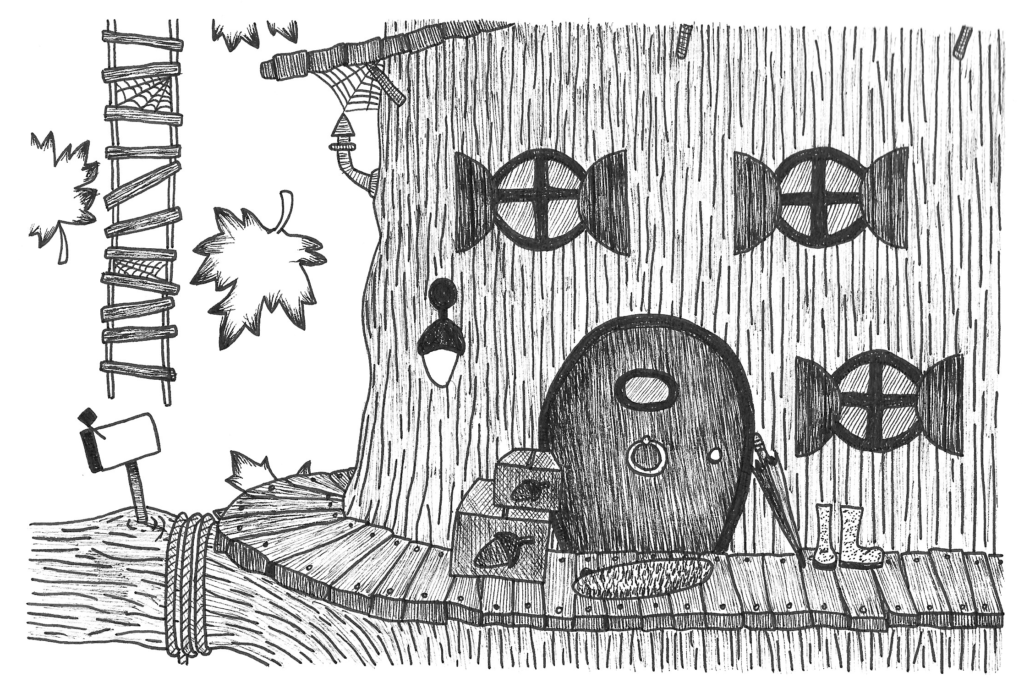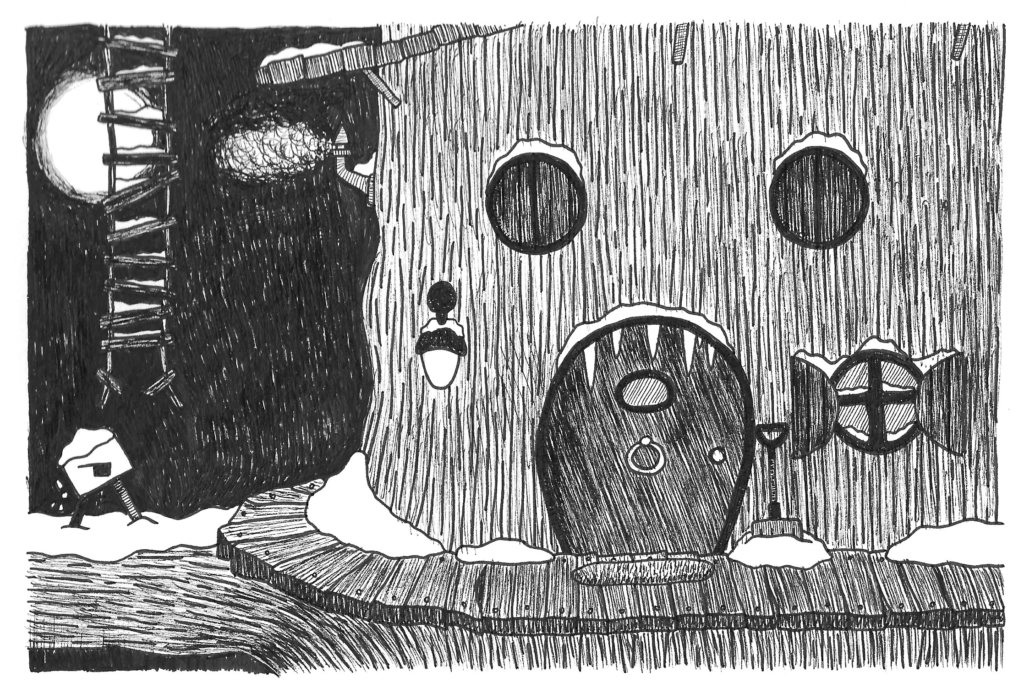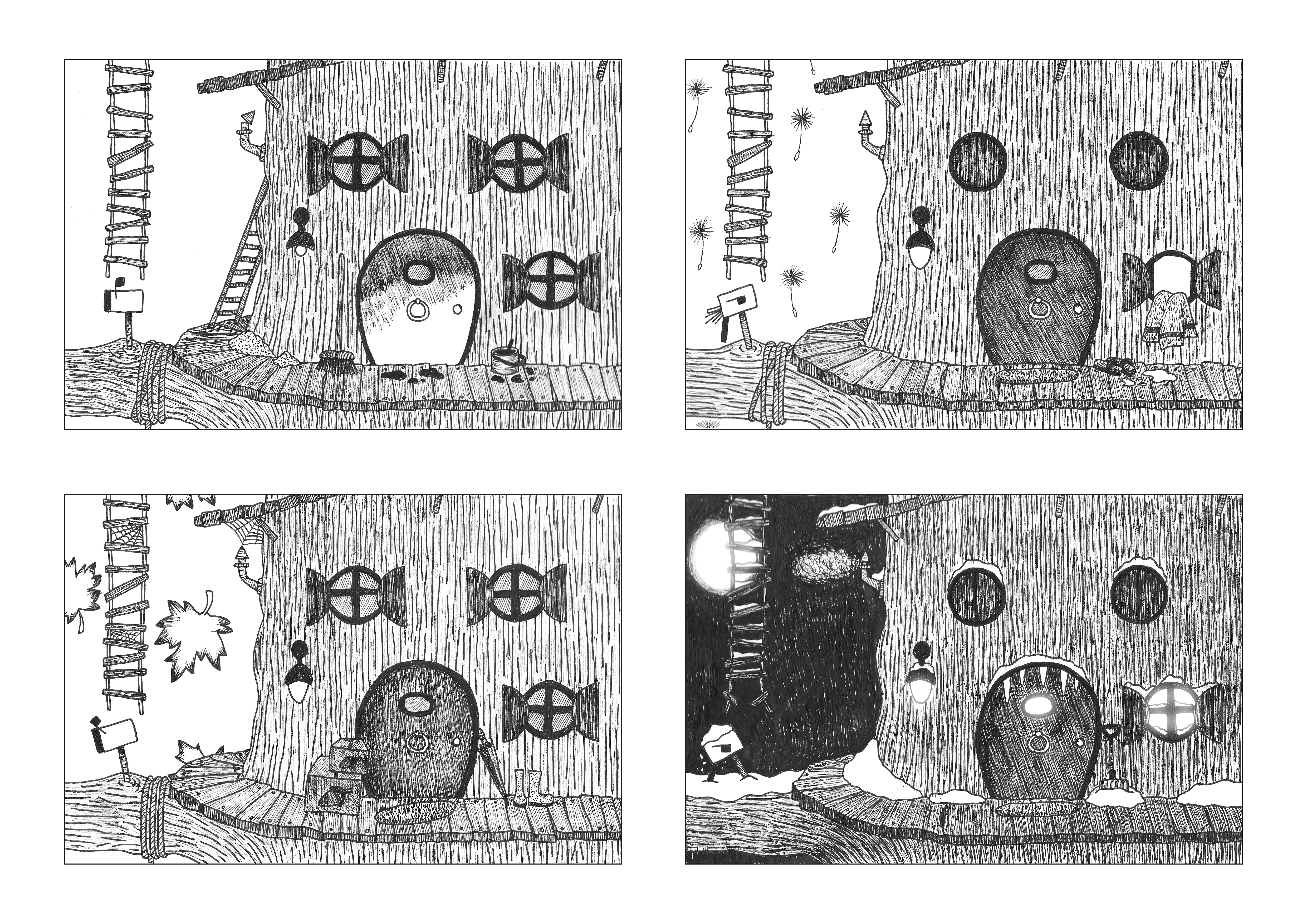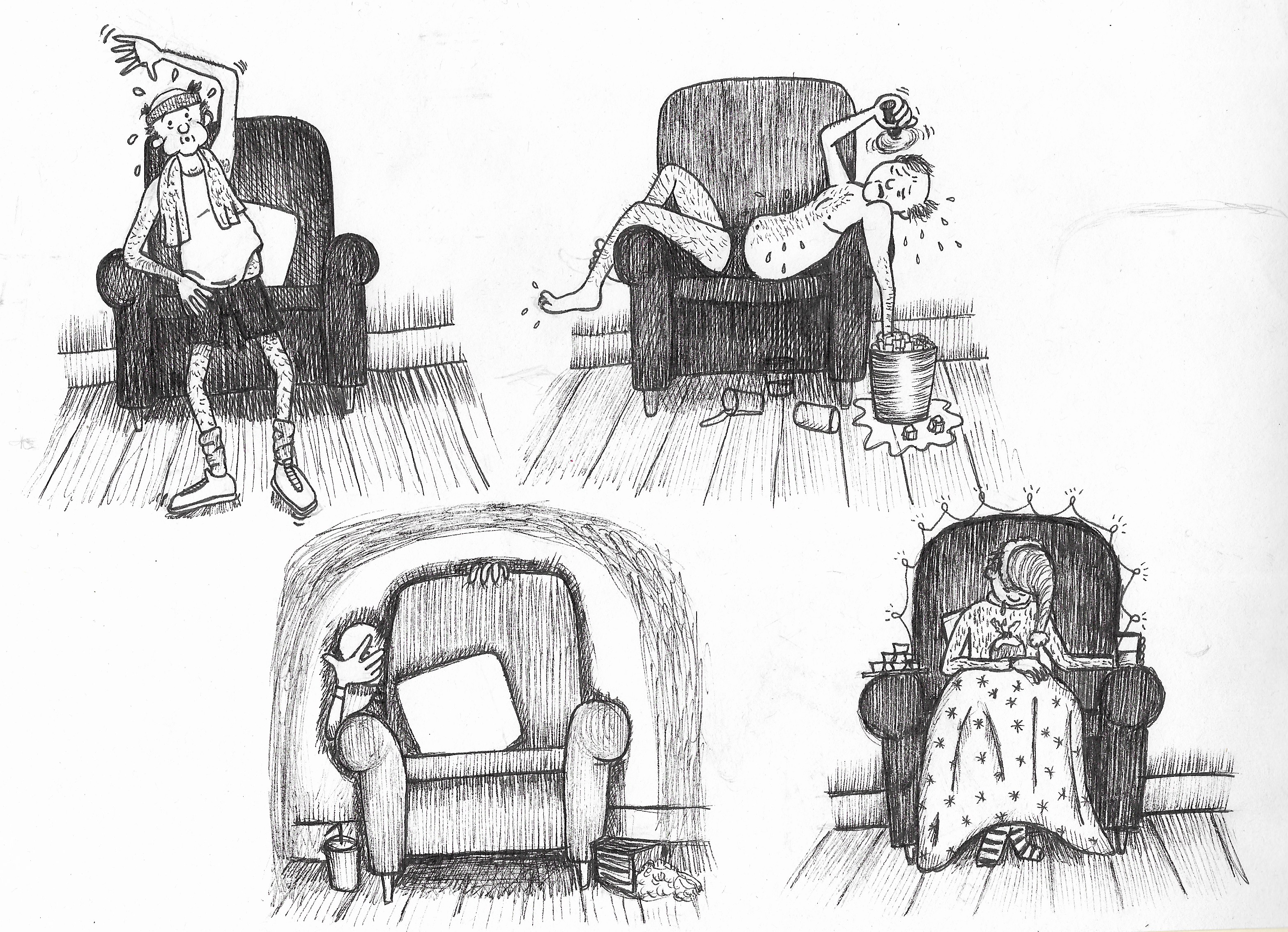Brief
Divide an A3 page into 4 equal-sized (18cm wide x 12cm high) ‘landscape’ pictures or panels.
Separately draw a single scene (of the same panel size) on a different sheet of paper to your ‘panel’ template. This could be a drawing of any place at any time.
Once you have drawn your template, lightly copy, or trace a copy of it, in pencil into each of the four panels you have four pale copies of your original scene.
Now draw in detail, ink in or colour each of the four panels as if it is set in one of the four seasons (Spring, Summer, Autumn and Winter). Try to make the the four pictures as varied as possible while keeping the same basic layout. Think of the different effects of light, weather, time of day and how they might change the way the spaces and details are visually communicated in each panel.
Write about the different challenges and techniques you used in each of the four pictures:
- What were the hardest textures or effects to achieve?
- How did you achieve the effects of day or night?
- Did you use tiny blobs of white paint to draw snowflakes, or scratch into black ink to create the effects of rain?
- Did you set all the scenes at the same time of day, or at different times?
Ideas
I began this assignment looking at the suggested research:
Robert Crumb’s A Short History of America (1979) – I thought this example succinctly demonstrated changes over time in one place, even though there are no specific time markers, the intentions are clear. It it just a typical part of America (but could represent most other places in the world), but sums up ‘progress’ of human development. Personally, I felt rather sad looking at how everything gets built over until there are no original natural features left at all (I liked the first picture best!).
Richard McGuire’s Here (2014) – the concept for this book really impressed me and I enjoyed looking at the example pages I could find online. The placement and choice of words/images along with the chosen colour palettes blend together very effectively – nothing appears disjointed or out of place. It also makes the reader stop and think about his/her place in history, what has gone before and that it will continue long after he/she is gone.
I then drew four mind-maps for each of the seasons.
I had three ideas in my head that I thought may be possibilities:
- The interior of a tree house (e.g. a woodland animal’s home) in which each season would be represented by changes to the interior decorations, views through the window and the position of the character. I wanted the character to be a squirrel.
- The exterior of a tree house (e.g. a woodland animal’s home) in which each season would be represented by changes to the weather and various clues to the character’s different activities at different times of the year (but the character would not be seen).
- The interior of a living room simply furnished in which each season would be represented by the movement of both the character and the furniture, along with the view through the window. This idea would be more humour-based.
I felt a bit overwhelmed by the prospect of the first idea, as I started developing quite vivid plans for a an entire storyline involving a squirrel, so at this stage I decided to explore the other two.
The ‘living room’ idea would be based on the character looking at a TV in each drawing, which cannot be seen and so he would appear to be looking out at the viewer. I found an example of the set-up I was thinking of in an illustration by Alex Gamsu Jenkins. I had a rough concept for each of the seasons:
Spring: the character would be on a health-kick doing an exercise routine (not very successfully). The sofa would be moved out of the way and he would have on his rarely used exercise kit.
Summer: the character would be lounging on the sofa in his underpants with a fan blowing at full speed.
Autumn: the character would be hiding behind the sofa as it is Halloween, watching a scary film. there would be pumpkin on the window ledge.
Winter: the character would be wrapped up in a blanket eating chocolates watching TV with a Christmas tree, etc. in the room.
I then drew a couple of very rough sketches for two for the seasons, which show my intentions more clearly than the above explanations.
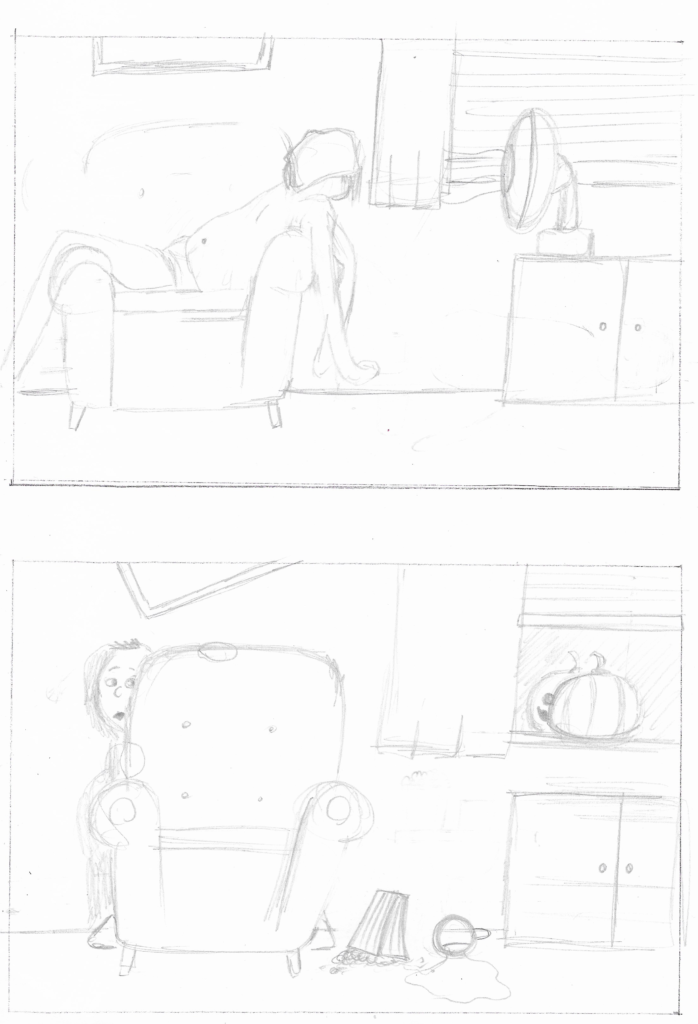
Although I quite liked the idea, I could imagine myself becoming fixated on trying to get the character to look ‘right’ and go off at a tangent rather than focusing on the objective of the assignment, i.e. to clearly demonstrate a change in seasons. Also I wanted to attempt to complete this assignment without resorting to my comfort zone of using Illustrator and refrain from working digitally altogether. I need to improve my drawing skills of scenes as well as characters so this assignment would be an ideal opportunity.
I therefore decided to move forward with the idea of an exterior view of a woodland animal’s tree house. I particularly liked the style of illustrations I found by an artist called Franco Matticchio.
Developing the Idea
I moved onto sketching out some possible compositions.
Once I was fairly satisfied with the composition I wanted to pursue, I drew it out at the true size of the final piece would be – I did not want to set myself up as usual by working on the details too small and then having to try to replicate this at a larger scale.
I thought that this composition would offer me various options to manipulate according to the season. I utilised my lightbox to create a cleaner version which I could then use as a template to work out the seasonal variations. It took me quite a while to think of how to depict the tree bark as I did not want it to dominate the picture.
Seasonal Variations
Next, I took four photocopies of the template and planned out what I could add to each to indicate the four seasons. I found this much harder than I expected, particularly because I realised I would have to draw by hand rather than using Illustrator, which I find much easier.
Spring
I decided to focus on a ‘spring-clean’ concept for the first season.
Summer
I found summer particularly tricky to come up with ideas for as there was not much room for additional items, e.g. such as a deckchair.
Autumn
I did consider adding a pumpkin for this season, but then felt that it would have to be tiny pumpkin and was unsure where to place it.
Winter
I found winter the easiest season to work on, which was a relief, although I was not sure how I would be able to depict the glow that I wanted to add from the windows, light and moon.
Using these plans, I used my lightbox with the template to draw out clean versions for each season.
I then moved onto adding ink to these pencil drawings. I used a fineliner for this.
I found it quite difficult working with the fineliner pen as the marks are permanent and I made quite a few mistakes, which made me feel quite frustrated! I like working digitally as it is fairly easy to make corrections. Additionally, I made the misjudgement of using the ink directly on top of the pencil version and when I tried to erase the pencil lines, many of them remained visible. This mistake was about to added to when I moved onto the next phase…
Considering Colour
At this point I became slightly stuck with what direction I should take in terms of adding colour, which is an area I do not feel confident with particularly using non-digital materials.
I decided to have a go using watercolours, which looked particularly amateurish, so I decided to make the situation worse by adding acrylic…
I then tried coloured pencils, but I was just not happy at all with my attempts and ability.
I then realised that I had just completely annihilated my ink drawings, so needless to say I had to take a break from the assignment at this point..!
Working on Final Illustrations
After some contemplation I decided to use my previous mishaps as an opportunity to make some improvements and I redrew the four illustrations using my lightbox and a fineliner. This time I chose to not use colour and instead work on my mark-making.
Although I was happier with these attempts than the previous ones, I still found myself focusing on mistakes and it was quite a challenge to accept these would be my final submissions.
Some improvements I would have like to make included:
- Moving the ladder to the right.
- Redrawing the window frames as they are so uneven.
- Adding more contrast by adding shadows and highlights.
- Adding something in the sky of the spring illustration.
- Adding an interior view for the lower window in the summer illustration.
- Redrawing the flip-flops, umbrella, boxes, wellingtons and paint pot!
Final Illustrations
I did manage to slip the use of Illustrator into the winter illustration as I really wanted to add the glowing light to the windows, light and moon per my original intentions. I felt this did improve the final result.
I also saved the drawings with a black background as I felt it added more of an impact, particularly to the winter one.
Final Thoughts
I can honestly say that this assignment was one of the most challenging to complete out of all the units I have done so far. Several times I genuinely wanted to give up and move onto the next section; try redoing it using digital tools instead; or attempt another idea instead. However, I persevered and managed to create a final result that, although not fully satisfactory to me, I was reasonably happy with and willing to submit.
Going forward I intend on continuing to work on my drawing skills, mark-making and understanding how to use colour effectively. I want to be able to add more detail and create better compositions.
On reflection, I learnt a great deal from this assignment – it highlighted that I need to learn to not be quite so self-critical of my work and it is fine to make mistakes as long as I learn from them. Additionally, I felt I did achieve the assignment’s main objective of depicting a change of time over the four seasons.
Reflections After Tutor Feedback
I was not completely satisfied with what I had managed to achieve for this Assignment, so taking into account both my tutor’s feedback and my own observations having looked over my submission after some time, I expanded on my original thoughts.
Idea 1
I was quite keen to develop my original concept of the character positioned in front of his sofa, looking at the TV (i.e. the viewer), and I felt more confident in being able to produce more comprehensive drafts to demonstrate my intentions.
I am not sure how successful these are at suggesting the character is watching TV, but perhaps I could include text underneath each illustration:
- Spring (top-left): “Stretch those sides! FEEL THE BURN!“
- Summer (top-right): “We are going to continue to see temperatures soar today...”
- Autumn (bottom-left): “Aaaaaaaaahhhhhhhhhhh!!!!!!!!“
- Winter (bottom-right): “…..”
My tutor commented on my intention to utilise the ‘fourth wall’ so that the character appeared to be looking straight at the viewer. This technique has been used very effectively, in my opinion, in such TV shows as Fleabag and This Is Going To Hurt. When the fourth wall is used, whether in illustrations, TV or film, it is as though the character is connecting directly with the viewer, whether it be verbally or via eye contact, for example. Sometimes I find it can be a bit disconcerting (in a positive way), especially if I am not expecting it or as though you are ‘in’ on a private joke/secret.
I still did not feel I had managed to convey this technique in my revised drafts above, but perhaps the Spring and Autumn images were my best attempts due to the character looking straight at the viewer in the former and the shadows being cast by the glare of the TV in the latter.
My tutor also queried why I decided to move on from Idea 1. This was mostly due to my lack of confidence that I would be able to produce a set of illustrations of a certain standard, particularly as these would included figure drawing. I took my tutor’s advice in these revised versions and edited out the other elements in the room, which were not necessary for the narrative of the drawings.
Thoughts on Final Piece
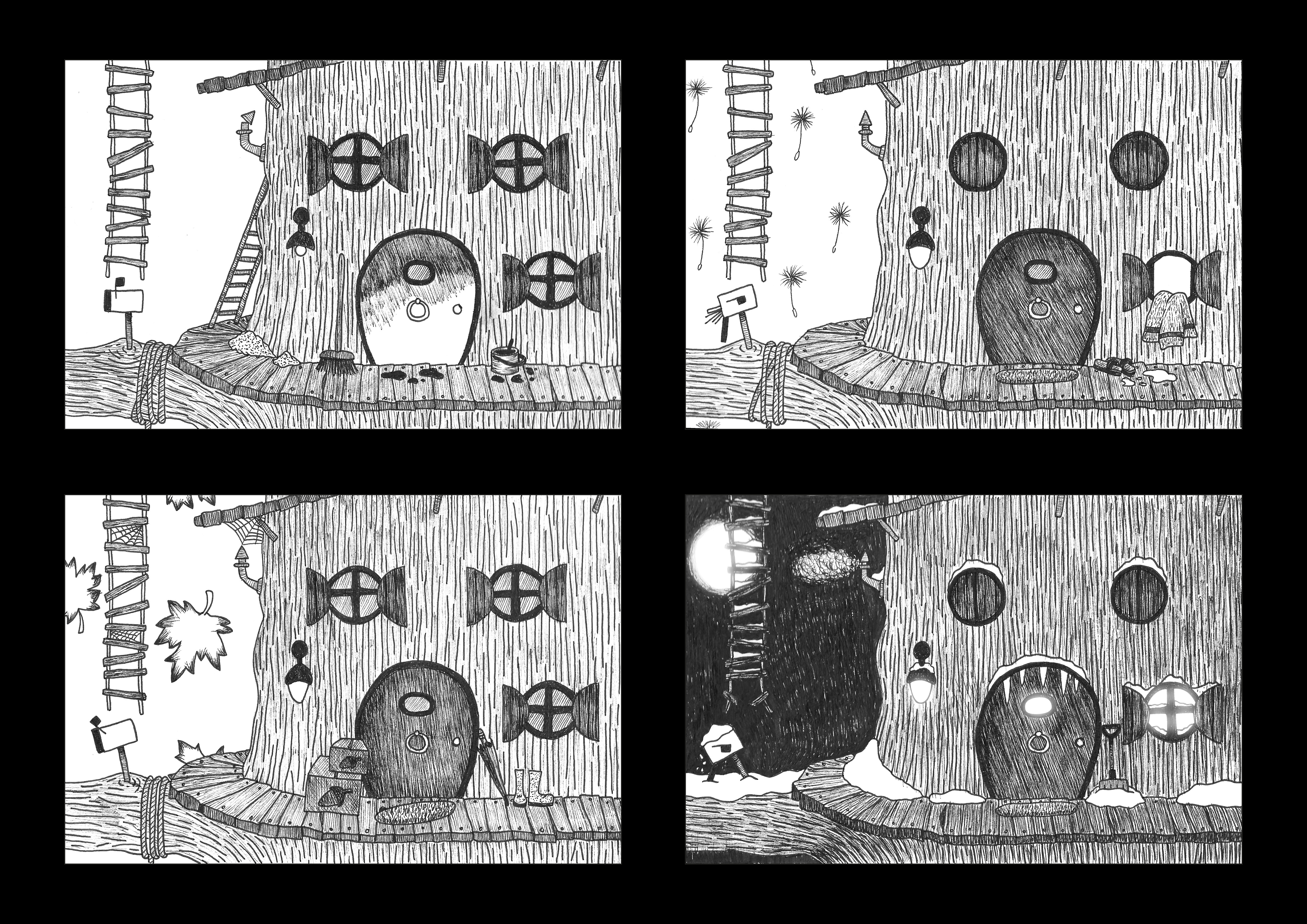
The only illustration from the set of four that I was relatively pleased with was the final one – winter. My tutor noted the inclusion of the ladder and this made me reconsider its inclusion – why would a squirrel (or any other tree-dwelling creature) need one? I believe I added it for its aesthetic contribution to the composition rather than considering its actual purpose…. A better alternative, I decided, would be to replace it with a pulley/hoist, which could be used for lifting heavy deliveries of acorns and the like to the tree’s residents. This could be shown in action in one of the scenes – probably autumn, when supplies would be hoarded for the colder months.
My tutor also commented on whether the absence of the character from any of the scenes was deliberate, that is were the clues included to make the viewer guess the identity of the resident. Although this was my intention, I do not believe the clues are clear enough to suggest this is indeed a squirrel. However, the main reason I did not include the character was probably due to my apprehension at the time of being able to draw a satisfactory squirrel. Perhaps I could have worked around this by just including glimpses, for example through an open window in the summer scene. Again, I did want to include the interior of the tree house in a couple of the scenes, but did not feel confident drawing this. If I was to repeat this ssignment I would have included the squirrel character in the following ways:
- Spring – the squirrel would seen in the process of giving his home a makeover, whether painting the door or up the ladder repairing the walkway above, for example.
- Summer – the doors and windows would all be open and I would try showing the squirrel returning from his swim with the towel around his neck, sunglasses and flip flops on. Alternatively I could show the squirrel opening the last top window, looking hot!
- Autumn – as previously stated, I would replace the ladder with the pulley/hoist system and show would choose to show the squirrel either pulling up a load of acorns/nuts or off loading them into his front door. I would possibly include another character in this scene.
- Winter – I would keep this scene more or less the same as logically the squirrel would be keeping warm inside his home. The major change would be to replace the ladder with the pulley/hoist, covered in snow.
References
Animalarium, (2009). The mysterious art of Franco Matticchio. [online] Available at: https://theanimalarium.blogspot.com/2009/07/mysterious-art-of-franco-matticchio.html [Accessed 2 September 2021].
Art of R. Crumb. Guide to My Collection, (2009). A Short History of America. [online] Available at: https://robertcrumb.blogspot.com/2009/04/short-history-of-america.html [Accessed 1 September 2021].
Bourton, L. (2018). Alex Gamsu Jenkins’ comics remind us of how gross we really are. [online] It’s Nice That. Available at: https://www.itsnicethat.com/articles/alex-gamsu-jenkins-illustration-061218 [Accessed 2 September 2021].
McGuire, R. (2014). Here. [online] Richard McGuire. Available at: https://www.richard-mcguire.com/new-page-4 [Accessed 1 September 2021]
Sutton, B. (2018). 10 Artists Who Unpacked the Symbolism of the Four Seasons. [online] Artsy. Available at: https://www.artsy.net/article/artsy-editorial-10-artists-unpacked-symbolism-four-seasons [Accessed 1 September 2021]
